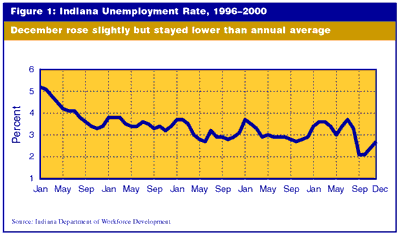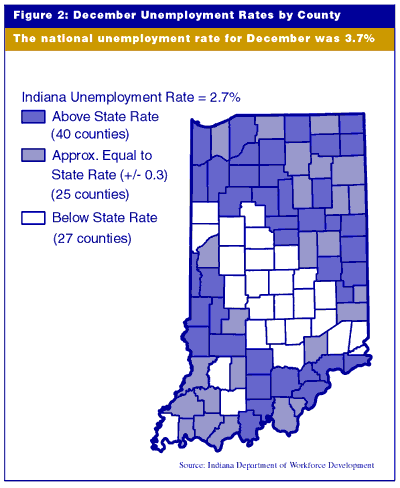December Unemployment Rate Did Not Signal Recession
Indiana's statewide unemployment rate for December 2000 came in at 2.7%, according to the Indiana Department of Workforce Development, showing no sign of a recession in the state. The 2.7% rate was still well below the average for the year. For the first 11 months of 2000 the state unemployment rate averaged 3.1%.
Indiana's non-seasonally adjusted unemployment rate continued to be less than the national average in December. The U.S. non-seasonally adjusted rate was 3.7%.
Talk of a possible recession in the U.S. economy has been widespread. Twice in the month of January, the Federal Reserve reduced its target interest rate. But those interest rate cuts were a preventive measure. Economic data through December do not show that a recession had begun. A good example is the unemployment rate in Indiana (see Figure 1).

Often an early sign of a recession is a large increase in unemployment. The Indiana rate, however, has been at very low levels for several years. In September, it took a major drop, to 2.1% from 3.3% in August.
September's number may have been influenced by unusual characteristics of the sample survey taken by the U.S. Census Bureau that month. The Indiana Department of Workforce Development relies in part on that monthly survey to calculate the state unemployment rate. By December, however, most of the effects of an unusual September sample should have disappeared from the data.
So if a recession were to show up in December's numbers, we should have seen the state rate not only climb back from the effects of September, but rise above the average of the preceding months. That did not happen.
Other states in this part of the country mirrored Indiana's experience in December. Illinois' rate was up slightly in December to 4.5%, but that did not significantly exceed its annual average. Michigan's rate actually fell, down to 3.4% from 3.5% in November. Both Kentucky and Ohio posted a December rate of 3.7%, unchanged from November.
A related measure of the health of the Indiana economy is monthly payroll statistics. Through another survey, the U.S. Bureau of Labor Statistics calculates the total number of jobs in each state each month. For Indiana, the December jobs number was 3,022,000. This total was nearly the same as the state job count in September, October and November. The average for the first 11 months of 2000 was 2,993,000, so December still remained above the average for the year.
If the data available for December do not show clear signs of recession, why all the recession talk? Part of the answer is the performance of individual sectors. While Indiana's overall economic health remained good through the last month of the year, certainly there were sectors—construction and durable goods manufacturing, for example—which showed more weakness than the rest of the state.
The December data also raised a question in another respect. The jobs number, while strong, did not increase. In most years, December brings an increase in jobs in Indiana.
Another warning sign: Although the state unemployment rate for January was not available at the time of this writing, the national unemployment rate for January had been announced. It was 4.7%, rising one whole percentage point from December. The January unemployment rate for Indiana will be covered in the next issue of IN Context.

